What is Om… Aum… ॐ… Video
Basic Meaning and Significance of the Profound Word and Mantra “Om”.
Presented by Vasundhara
Timeless Teachings Of Sages of India
Guidance for Meditation and Life from Sages and Great Gurus
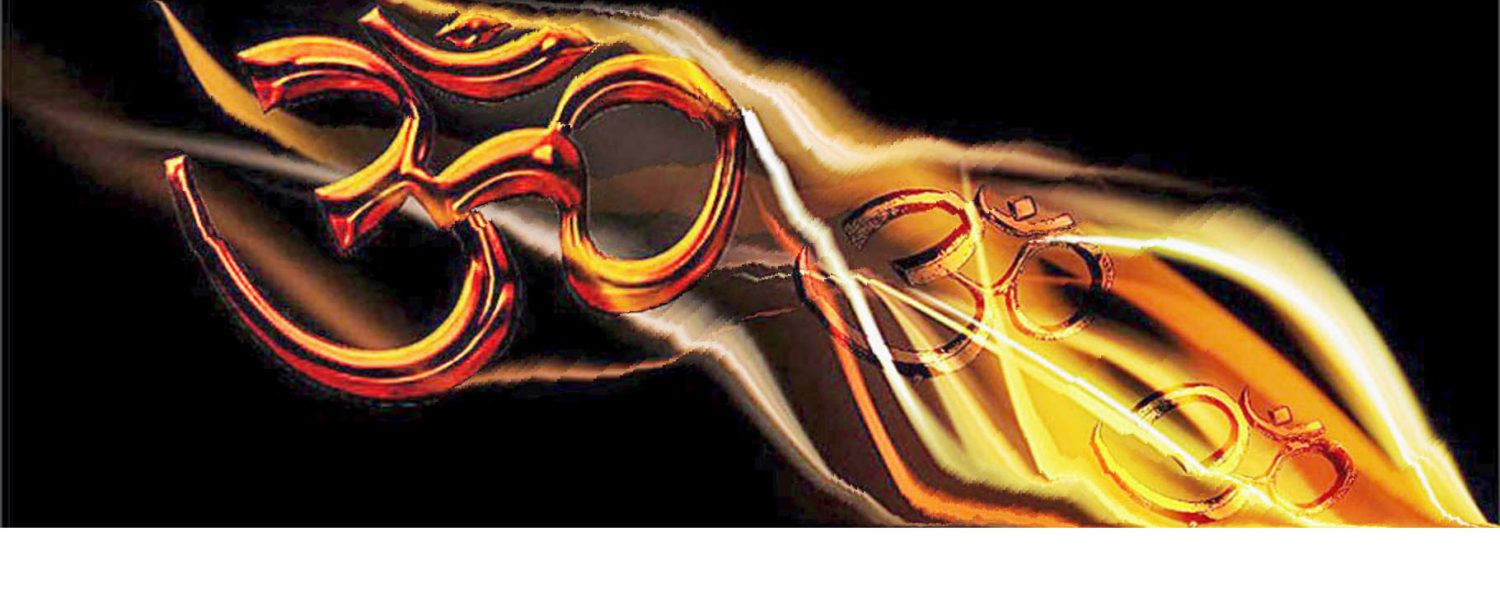
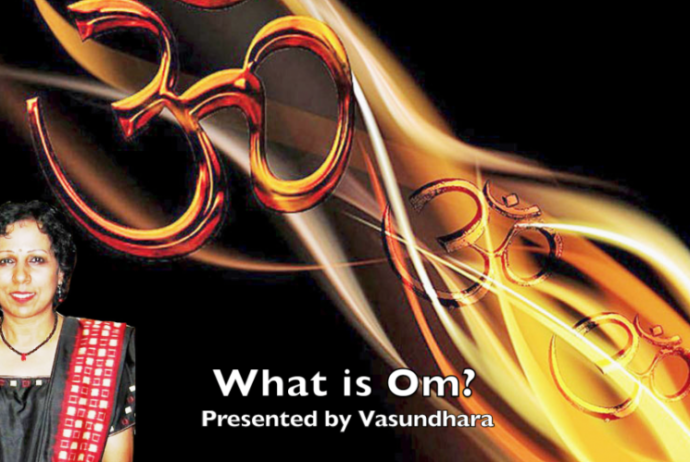
Presented by Vasundhara
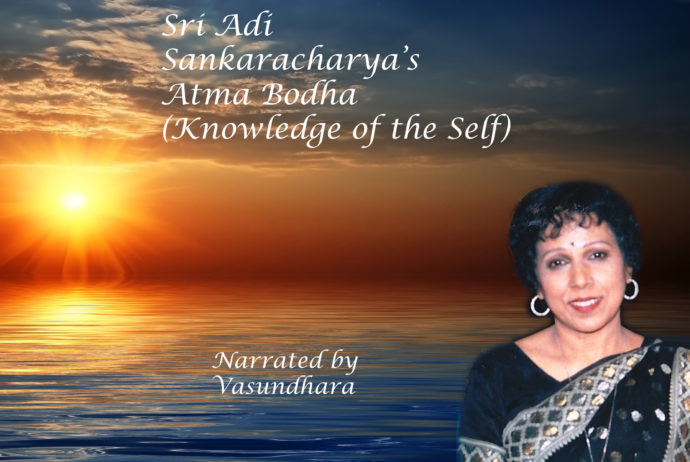
Narrated by Vasundhara

Narrated by Vasundhara

Narrated by Vasundhara
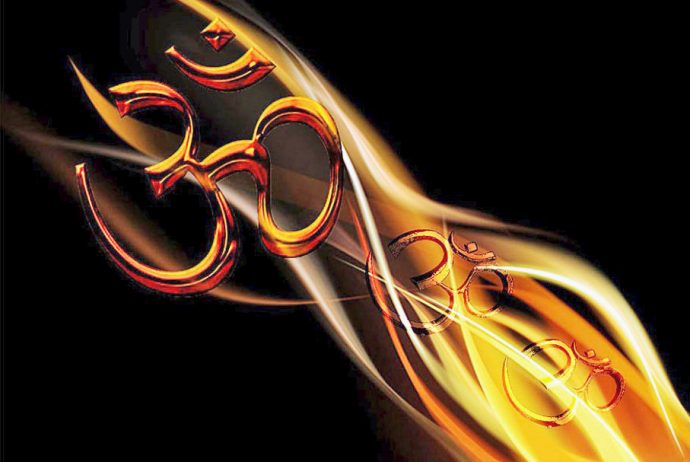
OM or AUM signifies the One Eternal Being which is The Beginning, Middle and End of All Beings.
On such a profound and important subject of Om, it is only right that I start with the authority of a Sage. In the words of Sri Ramana Maharshi : “In the sphere of speech, Pranava (the mystic sound AUM) represents the transcendental (nirguna). Om is the eternal truth. That which remains over after the disappearance of objects is Om. It does not merge in anything. It is the State of which it is said: “Where one sees none other, hears none other, knows none other, that is Perfection.” (Yatra nanyat pasyati, nanyat srunoti, nanyat vijanati sa bhuma.) All the upasanas are ways to winning it. One must not get stuck in the upasanas, but must query “Who am I?” and find the Self.”
Om represents the Eternal, Absolute, Unlimited, All-pervading, All-powerful, Blissful Reality, the One Self.
Om or Aum, is constructed with three sounds. A (pronounced as Ah), U (pronounced as Ooh), M (pronounced as Im as in him). Ah is the Beginning sound, Ooh is the Middle and Im is the End. A (Ah) emanates from deep in the body indicating the beginning, U (Ooh) emanates from the throat indicating the middle, M (Im) is said with closed lips, indicating the end. Together they indicate the Being-Consciousness-Bliss Self, as the One that is the Beginning, Middle and End of all Beings.
Again, A (Ah) refers to the Waking State, U (Ooh) refers to the Dream State and M (Im) refers to the Deep Sleep State. When Om or Aum is chanted, there is a brief silence afterwards. This Silence indicates the Absolute Blissful Being Reality.
Om, (Auṃ or Oṃ, Devanagari: ॐ) is a sacred sound and a spiritual icon in Hindu religion. It is also a mantra in Hinduism, Buddhism, Jainism, and Sikhism.
Om is part of the iconography found in ancient and medieval era manuscripts, temples, monasteries and spiritual retreats in Hinduism, Buddhism, and Jainism.
In Hinduism, Om is one of the most important spiritual symbols (pratima). It refers to Atman (soul, self within) and Brahman (ultimate reality, entirety of the universe, truth, divine, supreme spirit, cosmic principles, knowledge). The syllable is often found at the beginning and the end of chapters in the Vedas, the Upanishads, and other Hindu texts by great Sages of India. It is a sacred spiritual incantation made before and during the recitation of spiritual texts, during puja and private prayers, in ceremonies of rites of passages (sanskara) such as weddings, and sometimes during meditative and spiritual activities such as Yoga.
The syllable is also referred to as omkara (ओंकार, oṃkāra), aumkara (औंकार, auṃkāra), and pranava (प्रणव, praṇava).
The syllable Om is referred to as praṇava. Other used terms are akṣara (literally, letter of the alphabet, imperishable, immutable) or ekākṣara (one letter of the alphabet), and omkāra (literally, beginning, female divine energy).
The Om symbol ॐ is a ligature in Devanagari, combining ओ (au) and chandrabindu (ँ, ṃ).
Om came to be used as a standard utterance at the beginning of mantras, chants or citations taken from the Vedas. For example, the Gayatri mantra, which consists of a verse from the Rigveda Samhita (RV 3.62.10), is prefixed not just by Om but by Om followed by the formula bhūr bhuvaḥ svaḥ, waking, dream and deep sleep. Such recitations continue to be in use in Hinduism, with many major incantations and ceremonial functions beginning and ending with Om.
The syllable Om is first mentioned in the Upanishads, the mystical texts associated with the Vedanta philosophy. It has variously been associated with concepts of “cosmic sound” or “mystical syllable” or “affirmation to something divine”, or as symbolism for abstract spiritual concepts in the Upanishads. In the Aranyaka and the Brahmana layers of Vedic texts, the syllable is so widespread and linked to knowledge, that it stands for the “whole of Veda”.
The origin and historic foundations of Om are repeatedly discussed in the oldest layers of the Vedantic texts (the early Upanishads). The Aitareya Brahmana of Rig Veda, in section 5.32, for example suggests that the three phonetic components of Om (pronounced AUM) correspond to the three stages of cosmic creation, and when it is read or said, it celebrates the creative powers of the universe.
The Brahmana layer of Vedic texts equate Om with Bhur-bhuvah-Svah (waking, dream, deep sleep), the latter symbolizing “the whole Veda”. They offer various shades of meaning to Om, such as it being “the universe beyond the sun”, or that which is “mysterious and inexhaustible”, or “the infinite language, the infinite knowledge”, or “essence of breath, life, everything that exists”, or that “with which one is liberated”.
The Sama Veda, the poetical Veda, orthographically maps Om to the audible, the musical truths in its numerous variations (Oum, Aum, Ovā Ovā Ovā Um, etc.) and then attempts to extract musical meters from it.
Om is a common symbol found in the ancient texts of Hinduism, such as in the first line of Rig veda, as well as an icon in temples and spiritual retreats.
The syllable “Om” is described with various meanings in the Upanishads. Descriptions include “the sacred sound, the Yes!, the Vedas, the Udgitha (song of the universe), the infinite, the all encompassing, the whole world, the truth, the ultimate reality, the finest essence, the cause of the Universe, the essence of life, the Brahman, the Atman, the vehicle of deepest knowledge, and Self-knowledge”.
The Chandogya Upanishad is one of the oldest Upanishads of Hinduism. It opens with the recommendation that “let a man meditate on Om”. It calls the syllable Om as udgitha (उद्गीथ, song, chant), and asserts that the significance of the syllable is thus: the essence of all beings is earth, the essence of earth is water, the essence of water are the plants, the essence of plants is man, the essence of man is speech, the essence of speech is the Rig Veda, the essence of the Rig Veda is the Sama Veda, and the essence of Sama Veda is the udgitha (song, Om).
Chandogya Upanishad states that Rik (ऋच्, Ṛc) is speech, and Sāman (सामन्) is breath; they together produce song. The highest song is Om, asserts section 1.1.1. It says: “Let a man meditate on the syllable Om, called the udgitha; for the udgitha (a portion of the Sama-veda) is sung, beginning with Om.” It is the symbol of awe, of reverence, of threefold knowledge.
The second volume of the first chapter continues its discussion of syllable Om, explaining its use as a struggle between Devas (gods) and Asuras (demons). Ancient Indian scholars have considered this struggle between gods and demons as representing the good and evil inclinations within man, respectively. The legend in section 1.2 of Chandogya Upanishad states that gods took the Udgitha (song of Om) unto themselves, thinking, “with this song we shall overcome the demons”. The syllable Om is thus implied as that which inspires the good inclinations within each person.
Chandogya Upanishad’s exposition of syllable Om in its opening chapter combines the origin of Om, its metric structure and philosophical themes. In the second chapter of the Chandogya Upanishad, the meaning and significance of Om evolves into a philosophical discourse, such as in section 2.10 where Om is linked to the Highest Self, and section 2.23 where the text asserts Om is the essence of three forms of knowledge, Om is Brahman and “Om is all this”.
The Katho Upanishad is the legendary story of a little boy, Nachiketa – the son of sage Vajasravasa – who meets Yama, the Indian deity of death. Their conversation evolves to a discussion of the nature of man, knowledge, Atman (Soul, Self) and moksha (liberation). In section 1.2, Katho Upanishad characterizes Knowledge/Wisdom as the pursuit of good, and Ignorance/Delusion as the pursuit of pleasant, that the essence of Veda is make man liberated and free, look past what has happened and what has not happened, free from the past and the future, beyond good and evil, and one word for this essence is the word Om.
Katho Upanishad, 1.2.15-1.2.16 : Quote
The word which all the Vedas proclaim,
That which is expressed in every Tapas (penance, austerity, meditation),
That for which they live the life of a Brahmacharin,
Understand that word in its essence: Om! that is the word.
Yes, this syllable is Brahman,
This syllable is the highest.
He who knows that syllable,
Whatever he desires, is his.
Maitri Upanishad
The Maitrayaniya Upanishad in sixth lesson discusses the meaning and significance of Om. The text asserts that Om represents Brahman-Atman. The three roots of the syllable, states the Maitri Upanishad, are A + U + M. The sound is the body of Soul, and it repeatedly manifests in three: as gender-endowed body – feminine, masculine, neuter; as light-endowed body – Agni, Vayu and Aditya; as deity-endowed body – Brahma, Rudra and Vishnu; as mouth-endowed body – Garhapatya, Dakshinagni and Ahavaniya; as knowledge-endowed body – Rig, Saman and Yajur; as world-endowed body – Bhūr, Bhuvaḥ and Svaḥ (waking, dream, deep sleep); as time-endowed body – Past, Present and Future; as heat-endowed body – Breath, Fire and Sun; as growth-endowed body – Food, Water and Moon; as thought-endowed body – intellect, mind and pysche.[59][63] Brahman exists in two forms – the material form, and the immaterial formless.[64] The material form is changing, unreal. The immaterial formless isn’t changing, real. The immortal formless is truth, the truth is the Brahman, the Brahman is the light, the light is the Sun which is the syllable Om as the Self.
The Maitri Upanishad asserts : The world is Om, its light is Sun, and the Sun is also the light of the syllable Om. Meditating on Om, is acknowledging and meditating on the Brahman-Atman (Soul, Self).
Mundaka Upanishad
The Mundaka Upanishad in the second part, suggests the means to knowing the Self and the Brahman to be meditation, self-reflection and introspection, that can be aided by the symbol Om.
Mundaka Upanishad, 2.2.2 – 2.2.4 : Quote
That which is flaming, which is subtler than the subtle,
on which the worlds are set, and their inhabitants –
That is the indestructible Brahman.
It is life, it is speech, it is mind. That is the real. It is immortal.
It is a mark to be penetrated. Penetrate It, my friend.
Taking as a bow the great weapon of the Upanishad,
one should put upon it an arrow sharpened by meditation,
Stretching it with a thought directed to the essence of That,
Penetrate that Imperishable as the mark, my friend.
Om is the bow, the arrow is the Soul, Brahman the mark,
By the undistracted man is It to be penetrated,
One should come to be in It,
as the arrow becomes one with the mark.
Adi Shankara, in his review of the Mundaka Upanishad, states Om as a symbolism for Atman (soul, self).
The Mandukya Upanishad opens by declaring, “Om!, this syllable is this whole world”. Thereafter it presents various explanations and theories on what it means and signifies. This discussion is built on a structure of “four fourths” or “fourfold”, derived from A + U + M + “silence” (or without an element).
Aum as all states of time
In verse 1, the Upanishad states that time is threefold: the past, the present and the future, that these three are “Aum”. The four fourth of time is that which transcends time, that too is “Aum” expressed.
Aum as all states of Atman
In verse 2, states the Upanishad, everything is Brahman, but Brahman is Atman (the Soul, Self), and that the Atman is fourfold.
Aum as all states of consciousness
In verses 3 to 6, the Mandukya Upanishad enumerates four states of consciousness: wakeful, dream, deep sleep and the state of ekatma (being one with Self, the oneness of Self). These four are A + U + M + “without an element” respectively.
Aum as all states of knowledge
In verses 9 to 12, the Mandukya Upanishad enumerates fourfold etymological roots of the syllable “Aum”. It states that the first element of “Aum” is A, which is from Apti (obtaining, reaching) or from Adimatva (being first). The second element is U, which is from Utkarsa (exaltation) or from Ubhayatva (intermediateness). The third element is M, from Miti (erecting, constructing) or from Mi Minati, or apīti (annihilation). The fourth is without an element, without development, beyond the expanse of universe. In this way, states the Upanishad, the syllable Om is indeed the Atman (the self).
The Shvetashvatara Upanishad, in verses 1.14 to 1.16, suggests meditating with the help of syllable Om, where one’s perishable body is like one fuel-stick and the syllable Om is the second fuel-stick, which with discipline and diligent rubbing of the sticks unleashes the concealed fire of thought and awareness within. Such knowledge, asserts the Upanishad, is the goal of Upanishads. The text asserts that Om is a tool of meditation empowering one to know the God within oneself, to realize one’s Atman (Soul, Self).
Aitareya Aranyaka explains Om as “an acknowledgment, melodic confirmation, something that gives momentum and energy to a hymn”.
Om (ॐ) is the pratigara (agreement) with a hymn.
In this great scripture, recommended and referred to by Sri Ramana Maharshi, the very first verse starts with Om.
Salutation to Aum (undifferentiated Brahman, and yet the) Primal and Blissful cause, the transcendental consciousness shining as the unique mirror of the wonderful universe:
The Bhagavad Gita, in the Epic Mahabharata, mentions the meaning and significance of Om in several verses. For example, Verse 9.17 of the Bhagavad Gita says “Om which is the symbol for the indescribable, impersonal Brahman”.
Krishna to Arjuna, Bhagavad Gita 9.17 Quote:
I am the Father of this world, Mother, Ordainer, Grandfather, the Thing to be known, the Purifier, the syllable Om, Rik, Saman and also Yajus.
The significance of the sacred syllable in the Hindu traditions, is similarly highlighted in various of its verses, such as verse 17.24 where the importance of Om during prayers, charity and meditative practices is explained as follows :
Bhagavad Gita 17.24 : Quote
Therefore, uttering Om, the acts of yajna (fire ritual), dāna (charity) and tapas (austerity) as enjoined in the scriptures, are always begun by those who study the Brahman.
The aphoristic verse 1.27 of Pantanjali’s Yogasutra links Om to Yoga practice, as follows,
Yogasutra 1.27 : Quote
तस्य वाचकः प्रणवः ॥२७॥
His word is Om.
The Hindu deity Ganesha is sometimes linked to the symbol Om and as the symbol for Upanishadic concept of Brahman.
The medieval era texts of Hinduism, such as the Puranas adopt and expand the concept of Om in their own ways, and to their own theistic sects. According to the Vayu Purana, Om is the representation of the Hindu Trimurti, and represents the union of the three gods, viz. A for Brahma, U for Vishnu and M for Shiva. The three sounds also symbolise the three Vedas, namely (Rigveda, Samaveda, Yajurveda).
The Shiva Purana highlights the relation between deity Shiva and the Pranava or Om. Shiva is declared to be Om, and that Om is Shiva.
To Summarize, once again it is better that I quote the words of a Sage.
Sri Ramana Maharshi : “In the sphere of speech Pranava (the mystic sound AUM) represents the transcendental (nirguna). Om is the eternal truth. That which remains over after the disappearance of objects is Om. It does not merge in anything. It is the State of which it is said: “Where one sees none other, hears none other, knows none other, that is Perfection.” Yatra nanyat pasyati, nanyat srunoti, nanyat vijanati sa bhuma. All the upasanas are ways to winning it. One must not get stuck in the upasanas, but must query “Who am I?” and find the Self.”

Mahatma Gandhi – A Bright Beacon for the World to follow
Quotes on Pathway to God
By Vasundhara

Q: Another question. There is the person. There is the knower of the person. There is the witness. Are the knower and the witness the same, or are they separate states?
M: The knower and the witness are two or one? When the knower is seen as separate from the known, the witness stands alone. When the known and the knower are seen as one, the witness becomes one with them.
Q: Who is the jnani? The witness or the supreme?
M: The jnani is the supreme and also the witness. He is both being and awareness. In relation to consciousness he is awareness. In relation to the universe he is pure being.
Q: And what about the person? What comes first, the person or the knower.
M: The person is a very small thing. Actually it is a composite, it cannot be said to exist by itself. Unperceived, it is just not there. It is but the shadow of the mind, the sum total of memories. Pure being is reflected in the mirror of the mind, as knowing. What is known takes the shape of a person, based on memory and habit. It is but a shadow, or a projection of the knower onto the screen of the mind.
Q: The mirror is there, the reflection is there. But where is the sun?
M: The supreme is the sun.
Q: It must be conscious.
M: It is neither conscious nor unconscious. Don’t think of it in terms of consciousness or unconsciousness. It is the life, which contains both and is beyond both.
Q: Life is so intelligent. How can it be unconscious?
M: You talk of the unconscious when there is a lapse in memory. In reality there is only consciousness. All life is conscious, all consciousness — alive.
Q: Even stones?
M: Even stones are conscious and alive.
Q: The worry with me is that I am prone to denying existence to what I cannot imagine.
M: You would be wiser to deny the existence of what you imagine. It is the imagined that is unreal.
Q: Is all imaginable unreal?
M: Imagination based on memories is unreal. The future is not entirely unreal.
Q: Which part of the future is real and which is not?
M: The unexpected and unpredictable is real.
Nisargadatta Maharaj – I am That
The Jnani
Item 15b.
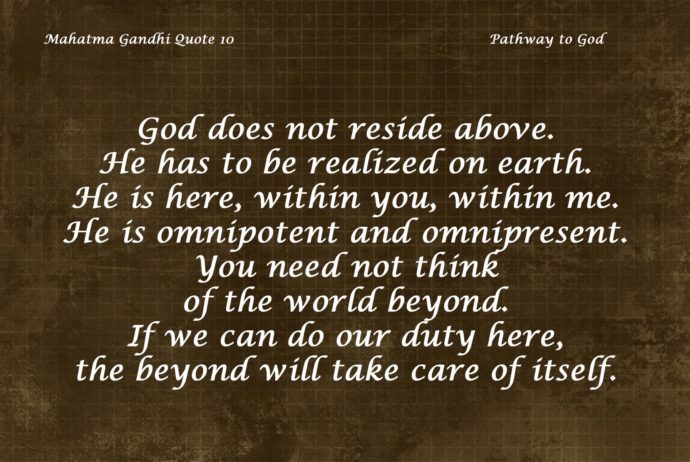
Mahatma Gandhi Teachings
Pathway to God
God does not reside above. He has to be realized on earth. He is here, within you, within me. He is omnipotent and omnipresent. You need not think of the world beyond. If we can do our duty here, the beyond will take care of itself.

Hindu Culture
The Definition of Culture
Talks by Swami Tejomayananda
A question is asked : how many different kinds of culture are there?
There are many communities and nations and each one has its own culture our tradition. Nevertheless we mainly divide our classify these cultures into two general groups : spiritual culture and material or materialistic culture. These words will also have to be understood very carefully.
In Sanskrit, spiritual culture is called “adhyatmic samskriti“, and materialistic culture is known as “bhautic samskriti“.
These terms are often and misunderstood, for we generally think that materialistic culture means to go on enjoying – just to eat drink and be merry! But this is a very superficial way of looking at it. At the same time, people have the notion that to be spiritual one has to renounce everything, to run off to the Himalayas and just sit there! So one person is saying, “enjoy the world” and the other is saying, “Escape! Run away from this world. Everything in it, is bad. Go somewhere far away and contemplate.”
Others have the notion that spiritual culture is very good, but materialism is very bad – that the people of a particular culture and their country are bad. Each person becomes proud of his own culture. The follower of the materialistic culture who does not fully understand spiritual culture says “you people are just getting poorer and poorer, your culture is useless.” Then those of the spiritual nature say to the materialist,” you are only running after objects, going through stress and strain, tension, and temptation. What kind of a life is that?” So each person thinks his own culture is superior. Most people do not have a clear understanding of what material culture and spiritual culture really mean, for it is not that one is good and the other is bad.
Some teenagers and youngsters say, “Oh, we know what spiritual culture is : when you see an elderly person, you must prostrate to him. That is called spiritual culture – prostration, salutation,.” And some parents insist insist on it so much that they push the child’s head down to touch to the elders feet; and the child just thinks,” why should I smell his feet?” Is this what spiritual nature is?
In Sanskrit, the term “bhautic vaada” (materialism) comes from the word bhuta,”Element”; “bhautic” means elemental. One generally takes as real only that which is directly in front of one’s eyes, which is tangible and in a material form. The philosophical basis of “bhautic vaada” is : seeing is believing”. Thus, whatever I see is real. Perception of the material tangible world is given complete validity and reality, and something that is not seen or known, for it is not verifiable by scientific experiment in the laboratory, is not accepted as real. Materialism means faith in matter, the physical things that are perceived by our senses. That this is why some people who have studied only a little bit of science say,” What is religion? Religion is only a matter of faith, and you are just accepting what you do not see.”
I met a man of few days ago in Washington DC who, while a student in Delhi, had met Dr. Radhakrishnan, the then Vice President of India. He had asked Dr. Radhakrishnan a question : “Sir, since you are a great philosopher, can you explain the difference between science and religion, as there seems to be a contradiction between the two? Religion speaks of something that is not seen, and people have faith in that. But in science one says,”No, I only accept what I see,” so it appears that scientists are anti-religious.”
Dr. Radhakrishnan gave a very nice answer. He said,” it is something like this : a little science takes you away from religion but more of it takes you near religion.” Dr. Radhakrishnan meant that those students who have studied only a little bit of science – atomic physics, particle physics and so on, speak of religion and God in derogatory terms. Einstein would not agree with this negative view, as is evident from his writings.
Thus the materialist has faith in, and bases his life upon, the supposed validity and the reality of seen things, whereas spiritual philosophy says,”Yes, whatever is seen is fine, But do not think that truth is only that which is seen by the senses.” There are many things that exist even though you cannot see them. Sense perception is not the only valid means of knowing what is it real. Through the senses we can only observe objects of the world, but there are things that lie beyond sense perception, and different means exist for knowing them.

Questioner: Without God’s power nothing can be done. Even you would not be sitting here and talking to us without Him.
Maharaj: All is His doing, no doubt. What is it to me, since I want nothing? What can God give me, or take away from me? What is mine is mine and was mine even when God was not. Of course, it is a very tiny little thing, a speck — the sense ‘I am’, the fact of being. This is my own place, nobody gave it to me. The earth is mine; what grows on it is God’s.
Q: Did God take the earth on rent from you?
M: God is my devotee and did all this for me.
Q: Is there no God apart from you?
M: How can there be? ‘I am’ is the root, God is the tree. Whom am I to worship, and what for?
Q: Are you the devotee or the object of devotion?
M: I am neither, I am devotion itself.
Q: There is not enough devotion in the world.
M.: You are always after the improvement of the world. Do you really believe that the world is waiting for you to be saved?
Q: I just do not know how much I can do for the world. All I can do, is to try. Is there anything else you would like me to do?
M: Without you is there a world? You know all about the world, but about yourself you know nothing. You yourself are the tools of your work, you have no other tools. Why don’t you take care of the tools before you think of the work?
Q: I can wait, while the world cannot.
M: By not enquiring you keep the world waiting.
Q: Waiting for what?
M: For somebody who can save it.
Q: God runs the world, God will save it.
M: That’s what you say! Did God come and tell you that the world is His creation and concern and not yours?
Q: Why should it be my sole concern?
M: Consider. The world in which you live, who else knows about it?
Q: You know. Everybody knows.
M: Did anybody come from outside of your world to tell you? Myself and everybody else appear and disappear in your world. We are all at your mercy.
Q: It cannot be so bad! I exist in your world as you exist in mine.
M: You have no evidence of my world. You are completely wrapped up in the world of your own making.
Q: I see. Completely, but — hopelessly?
M: Within the prison of your world appears a man who tells you that the world of painful contradictions, which you have created, is neither continuous nor permanent and is based on a misapprehension. He pleads with you to get out of it, by the same way by which you got into it. You got into it by forgetting what you are and you will get out of it by knowing yourself as you are.
Q: In what way does it affect the world?
M: When you are free of the world, you can do something about it. As long as you are a prisoner of it, you are helpless to change it. On the contrary, whatever you do will aggravate the situation.
Q: Righteousness will set me free.
M: Righteousness will undoubtedly make you and your world a comfortable, even happy place. But what is the use? There is no reality in it. It cannot last.
Q: God will help.
M: To help you God must know your existence. But you and your world are dream states. In dream you may suffer agonies. None knows them, and none can help you.
Q: So all my questions, my search and study are of no use?
M: These are but the stirrings of a man who is tired of sleeping. They are not the causes of awakening, but its early signs. But, you must not ask idle questions, to which you already know the answers.
Q: How am I to get a true answer?
M: By asking a true question — non-verbally, but by daring to live according to your lights. A man willing to die for truth will get it.
Nisargadatta Maharaj – I am That
The Jnani
Item 15a.
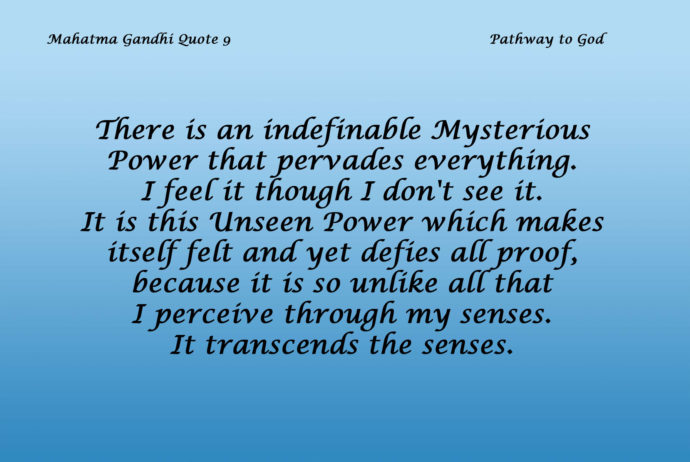
Mahatma Gandhi Teachings
Pathway to God
There is an indefinable Mysterious Power that pervades everything. I feel it though I don’t see it. It is this Unseen Power which makes itself felt and yet defies all proof, because it is so unlike all that I perceive through my senses. It transcends the senses.
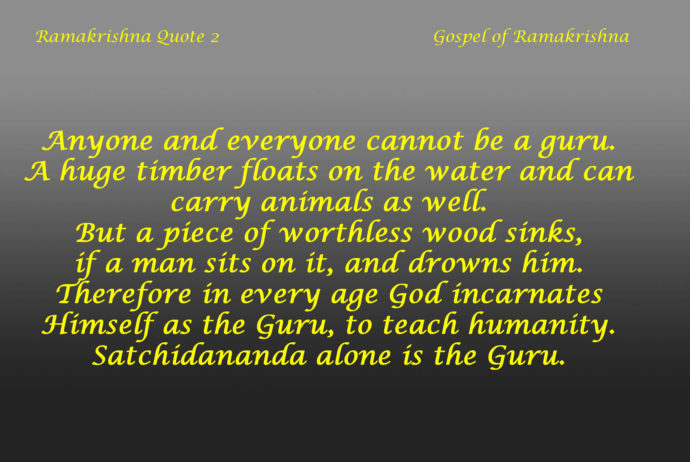
Ramakrishna Paramahamsa Teachings
Gospel of Sri Ramakrishna
Anyone and everyone cannot be a guru. A huge timber floats on the water and can carry animals as well. But a piece of worthless wood sinks, if a man sits on it, and drowns him. Therefore in every age God incarnates Himself as the Guru, to teach humanity. Satchidananda alone is the Guru.